Know the Etymology: 113
Place Name of the Day: Tuesday, 10 October 2017
Kūttaṉ-cīmā, Isaṉ-kaṉi-cīmai, Maḍul-sima, Kōraḷa-ima
கூத்தன்சீமா, இஸன்கனிசீமை, மடு₃ல்ஸிம, கோரள இம
Kūttaṉ-cīmā, Isaṉ-kaṉi-cīmai, Maḍul-sima, Kōraḷa-imaKūttaṉ+cīmā
Isaṉ+kaṉ+cīmai
Maḍul+sima
Kōraḷa+ima
The landholdings of a male dancer or settlement of the community of dancers
The landholdings of Isan Kani
The provincial limits or precincts
The divisional limits or precincts
| Cīmā | land-holdings, limit, a locality name suffix, a land-deed term, (Eezham Tamil place names). See boxes on Cīmai 1, Cīmai 2 and Sīmāva |
| Cīmai1 | from Cīrmai: an administrative unit, jurisdiction, a zemin or a feudal chief's territorial holdings during the Nāyakkar rule in Tamil Nadu (Tamil inscriptions, 1463 CE, TDI, ii, 23; SII, iv, 506; 1567 CE, SII, viii, 158); Cīr: measure, quantity, nature, greatness, goodness, wealth, esteem, reputation, fame (Tamil, DED 2624); Cīmai: land, country, territory, earth (Tamil, Civavākkiyar 134); country, territory, province, district, foreign country (Tamil, MTL); Cīmaip-paṟṟu: jurisdiction, seigniory, i.e., a noble man's domain such as a Zameen (Tamil, Winslow) |
| Cīmai2 | boundary (Tamil, inscription, 1250 CE, Epigraphia Carnatica, x, Bp. 37c); boundary, limit (Tamil, MTL); Catu-cīrmai: the four boundaries (Tamil, inscription, 1361 CE, Epigraphia Carnatica, X, Kl. 203). Sīmā: boundary (Tamil inscription, 953 CE, SII, xiii, 50); boundary (Pali, CDIAL 13435); boundary, field (Prakrit, CDIAL 13435); Sīmai: boundary point (Tamil inscription, 1000 CE, TASSI, 1958-59, p. 84); Sīman: parting of the hair (Sanskrit, Atharva Veda, CDIAL 13436); boundary (Sanskrit, Mahābhārata, CDIAL 13436); Sīmāntara: boundary of a village (Sanskrit, Mahābhārata, CDIAL 13438); Cimai: summit of a mountain, hair tuft (Tamil, DED 2544, Akanāṉūṟu, 138: 8); Civara: end, point, tip, extremity, (Telugu, DED 2544). See box on Sīmā in Sinhala |
| Sīmāva | (singular), Sīmā: (plural) boundary, limit, landmark, bank, shore (Sinhala, Clough); monastery land, "Bikṣūn saṅghakarma kirīma sańdahā sammata kara gannā lada sthānaya" (Sinhala, additional meaning given by Sorata); Sim: boundary, a limit (Sinhala, Clough); Simi: term found used in the meaning of boundary (Late Brahmi inscription, Tennakōngama, IC, vol II, 70); Hima: boundary (Sinhala, Clough); end, extremity, "Keḷavara", (Sinhala, additional meaning given by Sorata); Ima: (singular), Im: (plural) boundary, limit (Sinhala, Clough); belonging, attached, "Ayat", (Sinhala, additional meaning given by Sorata); Māyima: Mā+ima, boundary, limit (Sinhala, Clough); Sima: boundary, border (Old Dhivehi / Maldivian; it becomes Hima, Himen and Himma in the island names of Maldives; H/ S interchange); Sīmā: boundary (Pali, CDIAL 13435); boundary, field (Prakrit, CDIAL 13435); Sīman: parting of the hair (Sanskrit, Atharva Veda, CDIAL 13436); boundary (Sanskrit, Mahābhārata, CDIAL 13436); Sīmāntara: boundary of a village (Sanskrit, Mahābhārata, CDIAL 13438); Cimai: summit of a mountain, hair tuft (Tamil, DED 2544, Akanāṉūṟu, 138: 8); Civara: end, point, tip, extremity, (Telugu, DED 2544). See box on Cīmai 2 in Tamil |
| Ima | (singular), Im: (plural) boundary, limit (Sinhala, Clough); belonging, attached, "Ayat", (Sinhala, additional meaning given by Sorata); Māyima: Mā+ima, boundary, limit (Sinhala, Clough). See box on Sīmāva |
| Kūttaṉ | dancer, actor (Tamil, DED 1890); Kūtti: female actor, dancer (Tamil, DED 1890); Kūttar: dancers, theatrical performers (Tamil, DED 1890, Puṟanāṉūṟu, 28: 13-14); Kūttac-cākkaiyaṉ: member of a caste whose profession in ancient times was to sing and dance in temples and palaces (Tamil, DED 1890 + DED 2432; Cilappatikāram, 28: 67-78); Kūttu: dance, dramatic performance, strange event (Tamil, DED 1890, Kalittokai, 85: 34; 65: 29); from the root, Kuti: (verb) to jump, leap, bound, frolic (Tamil, DED 1705); (noun) heel of the foot (Tamil, DED 1707); (noun) dance (Campantar Tēvāram, 3: 89: 4); Tamiḻk-kūttu: dance indigenous to the Tamil country (Tamil, poet names, Akanāṉūṟu, 164, 256, 354; Puṟanāṉūṟu, 334; Tivākaram, 2: 55); Ciṅkaḷak-kūttu: the form of dance found in the Ciṅkaḷa (Sinhala) country, as differentiated from Tamil and other northern forms (Tamil, Pañcamarapu) |
| Maḍulu | (plural and combination) province, district, circumference (Sinhala, Clough); atoll, administrative district (Dhivehi/ Maldivian, DBF); Maḍulla: singular of Maḍulu (Sinhala, Clough); Maḍala: ring round the moon, orb, disk (Sinhala, Clough); Maṇḍala: disc, ball, circle, district, circular, (Sanskrit, CDIAL 9742); CDIAL cites Dravidian origin; Muṭalai: ball, globe (Tamil, DED 4919); from the root Muṭa: curve, bend (Tamil, DED 4919, Kuṟuntokai, 209: 5); Muṭṭai: egg, world as globe, universe as globe (Tamil, DED 4939, Kuṟuntokai, 38: 1; Puṟanāṉūṟu, 173: 6-7; Cuntarar Tēvāram, 14: 33); Maṭi: (verb) to be folded, to curl (Tamil, DED 4645); Maṭaṅku: (verb) to become bent (Tamil, DED 4645); Maṇṭilam: circle, continent surrounded by sea (Tamil, Kuṟuntokai, 300: 7); disc of the Sun (Tamil, Naṟṟiṇai, 67: 1); disc of the Moon (Tamil, Naṟṟiṇai, 375: 7); the Earth (Tamil, Akanāṉūṟu, 104: 5); Maṇṭai: head, skull, earthen vessel (Tamil, DED 4682); cognates in 10 Dravidian languages. See column 445 |
| Kōraḷa | administrative division, "Janapadaya" (Sinhala, Sorata, inscription, EZ, iii, 65); the chief of an administrative division, "Kōraḷayak pālanaya karaṇa mulādẹniyā" (Sinhala, Sorata, inscription, EZ, iv, 30); Kōralē: (singular), Kōrala: (plural) part of a province, division (Sinhala, Clough); Kōrāla: the chief of a Kōralē (Sinhala, Clough); Kūṟu: section, division, part, share (Tamil, DED 1924, inscription, 73i CE, SII, viii, 331); Kūṟṟam: administrative division (Tamil, inscription, 771 CE, SII, v, 405); Kōṟu: part, portion (Kannada, DED 1924); a share (Telugu, DED 1924); Kuṟai: (verb) to cut; (noun) piece section (Tamil, DED 1859, Caṅkam diction, Maturaikkāñci, 320; Puṟanāṉūṟu, 231: 1); Koṟē: (verb) to cut (Kannada, DED 1859); Kōrā: a cut-off portion (Telugu, inscriptions, DED 1859); cognates in 13 Dravidian languages. See column 209 |
| Isankani | a Muslim personal name (Islamic Tamil) |
The terms Sīmā and Sīmai, written with Grantha S, and used in the meaning of boundary, appears in Tamil inscriptions after 10th century CE.
Used in the same meaning, the forms, Cīmai and Cīrmai are seen in Tamil inscriptions after 13th century CE.
Cīmai and Cīrmai were meaning a feudal unit, fiefdom, principality, or a territory/ country in general, in Tamil inscriptions and literature coming after 15th century CE.
In Eezham Tamil place names, Cīmā and Cīmai mean land holdings. The terms come in some locality names or in land deed names.
In Sinhala, Sim, Sīmā, Sīmāva, Hima and Ima mean a boundary or limit. In these meanings, Sima and Ima are the forms that are seen in Sinhala place names.
A form Simi, in the meaning of boundary, is seen in the late Brahmi inscriptions of the island.
The terms correspond to Sīmā meaning boundary in Pali and Prakrit, and Sīman meaning the same in Sanskrit.
As found in Atharva Vedic usage, Sīman in Sanskrit was originally meaning 'parting of the hair', from which the boundary meaning seems to have come.
The Tamil/ Dravidian term Cimai meaning summit of a mountain and hair tuft is probably analogous.
However, the use of Grantha S for Sīmā meaning boundary in 10th century CE Tamil inscriptions may show that the term is either routed through Sanskrit or is a Sanskrit/ Prakrit loan word.
Cīrmai/ Cīmai meaning a feudal landholding, principality etc. in Tamil may have another etymological origin from the root Cīr (see box on Cīmai 1), or it may be a usage of conflation, mixing up meanings of Cīr and Sīmā.
* * *Cīrmai as feudal landholding, Zemin or fiefdom in the Vijayanagar times:"மலை நின்றான் திருனந்தவநத்திற்குக் கடவ கொப்பய்யன் சீர்மையாக கட்டளை பண்ணுகையில்" (Tamil inscription, 1465 CE, TDI, ii, 23)
"Malai niṉṟāṉ tiruṉantavanattiṟkuk kaṭava koppayyaṉ cīrmaiyāka kaṭṭaḷai paṇṇukaiyil" (Tamil inscription, 1465 CE, TDI, ii, 23)
While giving an endowment to the sacred flower garden of Malai-niṉṟān (the deity standing on the hill) on behalf of the Cīrmai (feudal land holding) of Koppaiyaṉ (a feudal lord)
Cīrmai as principality in the Vijayanagar times: "தஞ்சா ஊற் சீர்மை மணற்பிடினாடு" (Tamil inscription, 1463 CE, SII, iv, 506)
"Tañcā ūṟ cīrmai maṇaṟpiṭiṉāṭu" (Tamil inscription, 1463 CE, SII, iv, 506)
The Maṇatpiṭi Nāṭu division of Tañcāvūr Cīrmai (principality)
Cīmai as a feudal unit in the Vijayanagar times:"இராயப்பரசர் திருவண்ணாமலை சீமை குத்தகை கட்டிக்கொண்டனாளிலே" (Tamil inscription, 1567 CE, SII, viii, 158)
"Irāyapparacar Tiruvaṇṇāmalai cīmai kuttakai kaṭṭikkoṇṭaṉāḷilē" (Tamil inscription, 1567 CE, SII, viii, 158)
At the time when Irāyapparacar (a Nāyakka chief) acquired on lease the Cīmai of Tiruvaṇṇāmalai (the territory coming under the purview of the central place, Tiruvaṇṇāmalai)
Cīmai as a general term for territory or country:"சீமை எங்கும் ஆணும் பெண்ணும் சேர்ந்து உலகம் கண்டதே" (Civavākkiyar, 134, c. 13-15 century CE)
"Cīmai eṅkum āṇum peṇṇum cērntu ulakam kaṇṭatē" (Civavākkiyar, 134, c. 13-15 century CE)
In every territory/ country, male and female together make this world
* * *Sīmā meaning boundary:"எங்களில் ஸீமா விவாதமாய்க் கிடந்த நிலம்" (Tamil inscription, 953 CE, SII, xiii, 50)
"Eṅkaḷil sīmā vivātamāyk kiṭanta nilam" (Tamil inscription, 953 CE, SII, xiii, 50)
The land that had boundary dispute among us
Sīmai meaning boundary points:"பிடி சூழ்ந்து ஸீமை தெரிந்துக் கல்லுங் கள்ளியு நாட்டி" (Tamil inscription, 1000 CE, TASSI, 1958-59, p. 84)
"Piṭi cūḻntu sīmai terintuk kalluṅ kaḷḷiyu nāṭṭi" (Tamil inscription, 1000 CE, TASSI, 1958-59, p. 84)
Walking an elephant around (the limits of the land that is given), identified the boundary points or corners and setting boundary stones and planting cactus there
Cīmai meaning boundary: "ஏரி…வாய்க்குத் தெற்குஞ் சீமையாக விட்டு" (Tamil inscription, 1250 CE, Epigraphia Carnatica, vol X, Bp. 37c)
“Ēri…vāykkut teṟkuñ cīmaiyāka viṭṭu” (Tamil inscription, 1250 CE, Epigraphia Carnatica, vol X, Bp. 37c)
Keeping the south of the tank's mouth as boundary
Cīrmai meaning boundary point or corner:"நால் பால் எல்லையும் சது சீர்மைக்கு கல்லும் நாட்டி விட்டோம்" (1361 CE, Epigraphia Carnatica, X, Kl. 203)
"Nāl pāl ellaiyum catu cīrmaikku kallum nāṭṭi viṭṭōm" (1361 CE, Epigraphia Carnatica, X, Kl. 203)
We laid boundary stones at the four boundary corners, setting the four sides of the boundary
* * *Kūttu meaning dance or theatrical performance in Tamil comes from the root Kuti as a verb meaning to jump and as a noun meaning the heel of foot.
Early usage examples of Kūttu:"கூத்தர் ஆடு களம்" (புறநானூறு, 28: 13-14)
"Kūttar āṭu kaḷam" (Puṟanāṉūṟu, 28: 13-14)
The stage for the performance of dancers or dramatists
"கொல்லையின் நின்று குதி கொள்ளும் கூத்தன்" (திருமூலர், 532)
"Kollaiyiṉ niṉṟu kuti koḷḷum kūttaṉ" (Tirumūlar, 532)
The Kūttaṉ (Siva as dancer) dancing in the forest [This has another mystic meaning in the usage of Tirumūlar]
"ஆடுங் கூத்தியர்" (மணிமேகலை, 12: 51)
"Āṭuṅ kūttiyar" (Maṇimēkalai, 12: 51)
Dancing women
* * *Kūttaṉ-cīmā is a locality in Aḷaveṭṭi North in Valikamam North division of Jaffna district. The place name is sometimes spelt as Kūttañ-cīmā. The locality was once known for its legendary female dancers, who a few generations ago had the reputation of performing even in the temples of Tamil Nadu.
Isan-kani-cīmai is in Akkaraippattu division of Amparai district.
Maḍul-sima is a large village in Lunugala division of Badulla district. In the past it was the headquarters of a division by its name.
Kōraḷa-ima: is a place in Horana division of Kalutara district
* * *Some related place names:Cīmā:Celli-cīmā: Karaveṭṭi, Vadamaradchi Southwest, Jaffna (V. Almanac, 2013-14, p. 91)
Veḷic-cīmā: Mayiliṭṭi North, Valikamam North, Jaffna
Periya-cīmā: Kokkuvil, Nallur, Jaffna (land deed name, Balasundaram, p. 105)
Paruttic-cīmā: Kokkuvil, Nallur, Jaffna (land deed name, Balasundaram, p. 105)
Pattiṉi-cīmā: Kokkuvil, Nallur, Jaffna (land deed name, Balasundaram, p. 105)
Pālaṉ-cīmā: Kokkuvil, Nallur, Jaffna (land deed name, Balasundaram, p. 105)
Marutañ-cīmā: Kokkuvil, Nallur, Jaffna (land deed name, Balasundaram, p. 105)
Rāmaṉ-cīmā: Kokkuvil, Nallur, Jaffna (land deed name, Balasundaram, p. 105)
Puṅkañ-cīmā: Tumpaḷai, Vadamaradchi Northeast, Jaffna (locality name, Balasundaram, p. 57)
Mōṭṭaṉ-cīmā: Alvāy, Vadamaradchi Southwest, Jaffna (Balasundaram, p. 266)
Civanta-marakkāyaṉ-cīmā: Pulōli, Vadamaradchi Southwest, Jaffna (Balasundaram, p. 393)
Cīmā-veḷi: north of Puttaḷam Town, Puttalam (Puttalam OIS)
* * *Sima:Sima-toḍuva: from Cīmā-toṭuvāy: Kaṟpiṭṭi, Puttalam (Kalpitiya OIS). The place is located at the mouth of a sea-inlet (Toṭuvāy), which was earlier the boundary of Kaṟpiṭṭi North and the South Paṟṟus (divisions)
* * *Ima:Gaň-ima-yāya: Naula, Matale
Ima-duva: Imaduwa, Galle
Imā-ḍuva: Laggala-Pallegala, Matale. See Ima-duwa
* * *Kūttaṉ/ Kūtti:Kūttaṉ-kalaṭṭi: a locality in Vēlaṇai, Kayts, Jaffna (V Almanac, 2013-14, p. 99)
Kūttāṭi-marutamaṭuk-kuḷam: Madu, Mannar
Kūtti-vaḷavu: a locality in Vīmaṉkāmam, Vadamaradchi North, Jaffna (Balasundaram, p. 181)
Kūtti-mūlai: Vavuṉikkuḷam, Manthai East, Mullaiththeevu. The place is now called Poṉṉakar
Nakkiyam-pulam: Valikamam South, Jaffna. Nakki: female temple dancer
Nakkaṉā-vaṭṭai: Valikamam North, Jaffna (Balasundaram, 184). Nakkaṉ: female temple dancer
Karakattāṉ-pulam: Polikaṇṭi, Point Pedro, Jaffna. Karakattāṉ: male Karakam dancer
* * *Notes on the etymology of Kūttu and related words in Tamil:The Tamil/ Dravidian term Kūttu meaning dance (DED 1890) comes from the root Kuti, which as a verb means to jump and as a noun means the heel of the foot (DED 1707).
The etymology of Kūttu is comparable to the other terms for dance in Tamil/ Dravidian, such as Āṭu (verb: to move, DED 347, Aṭi: foot, DED 72) > Āṭṭam (dance); Naṭa (verb: to walk, DED 3582) > Naṭam (dance; Nāṭakam: drama); Kummu (verb: to clap, DED 1756) > Kummi (a form of dance accompanied with clapping of hands); Kuṉi (verb: to bend, DED 1927) > Kuṉippu (dance, DED 1863); Kōlam (costume, dance, DED 2240); Tāṇṭu (verb: to leap, jump, DED 3158, Tāḷ: leg, DED 3185) > Tāṇṭavam (a male dance, dance of Siva); Noṇṭu: (verb: to limp, DED 3786) > Noṇṭi (stilt dance); Tuḷḷu (verb: to jump, DED 3364) > Tuḷḷal (Dance); Kurai (verb: to shout, jubilate, DED 1796); Kural: voice, DED 1774) > Kuravai (a dance accompanied with singing) and Tuḷaṅku (to move, to sway from side to side, DED 3359, also to shake, be perturbed; Tuṇukku: be agitated, DED 3359) > Tuṇaṅkai 1 (a kind of devil dance); > Tuṇaṅkai 2 (an embracing dance of men and women, it could also be from Tuṇaik-kai: holding in union).
* * *Notes on Eezham Tamil Kūttu and Kūttar: Kūttu is a Tamil/ Dravidian word for dance, drama and theatre, found used since Caṅkam times. Professionals or a clan of people who performed them were called Kūttar. Both males and females were members of this group. (Kūttaṉ: singular masculine; Kūtti: singular feminine; Kūttar: plural masculine and Kūttiyar: plural feminine).
The references to Tamiḻik-kūttar in the Caṅkam literature and Ciṅkaḷak-kūttu in medieval Tamil text, Pañca Marapu, indicate the prevalence of indigenous forms of theatre in the region, right from early times.
A literature like Cilappatikāram comes out with a wide classification of the kūttu forms found in the Tamil tradition. The references to Naḍa (professionals or clan of theatre artists) in the Brahmi inscriptions of Ilaṅkai also should be noted in this context. The Ciṅkaḷak-kūttu, according to Pañca Marapu, was slower in motion compared to the other types.
The Pāṇar-Viṟaliyar-Kūttar tradition of the Caṅkam times later evolved in two ways in the Tamil culture. One stream, synthesized as the classical Bharata-nāṭṭiyam, became associated with temples and socially evolved into the Naṭṭuvar-Tēvatāci (Dēvadāsi) institution. The other stream remained at folk level and retained the term Kūttu.
The degeneration of both the institutions and the changed social status of the artists are reflected in the derogatory meanings in later Tamil for the words Tāsi, Tēvaṭiyāḷ, Kūtti, Kūttiyāḷ, etc. (Note all of them feminine forms). They meant prostitute, concubine or a woman of loose morals.
Both the said streams were flourishing in the Eezham Tamil culture.
Documentary evidences are available for the popularity of the Tēvatāci institution associated with the temples of Tirukkōvil (Batticaloa) and Tirukōṇamalai (Trincomalee) in the Eastern province and with Vaṇṇārpaṇṇai and Nallūr in Jaffna (James Cordiner on Tirukkōvil; Kōṇēcar Kalveṭṭu on Trincomalee, Kaṉaki Purāṇam on Vaṇṇārpaṇṇai and Navalar's writings on Nallūr Kantacāmi temple).
An Eezham Tamil female dancer attached to Poṉṉampalavāṇēsvarar temple of Colombo wrote a book on the institution of female dancers and her family tradition in 1911. This book, available in the Jaffna University library, is in a highly decayed condition.
Another Eezham Tamil scholar, Ampalavāṇa Nāvalar, supervised a publication in the late 19th century, on the etiquette of female dancers and the kinds of dances they have to perform on various occasions in the temples.
The community of the performing artists was matriarchal. Children went after mother's name. The initials found in the name of the late, A. Cē. Murukāṉantam, the well-known Eezham Tamil writer belonging to the community, stood for Aḷaveṭṭi, his place of birth and Cellakkaṇṭu, his mother's name. This was similar to the practice of the community in Tamil Nadu, as could be seen in the name of the world-renowned singer, the late M.S. Subbulakshmi: Madurai (place) and Shanmugavadivu (mother's name).
In Jaffna peninsula, Aḷaveṭṭi and Iṇuvil were the strongholds of the artists of the traditional institutions. Traditional female artists prevailed until 1960s in these villages.
The dance by female artists on the occasion of temple festivals was known by the names Ciṉṉa-mēḷam, Catir, Catirk-kaccēri or Catir-āṭṭam. The term Ciṉṉa-mēḷam is especially of Eezham Tamil usage. It literally means the 'little drum'.
It was called so, because the dance was accompanied by a musical instrument called Mattaḷam (Mridaṅgam), which is a smaller percussion instrument compared to Mēḷam, a bigger one. The dance used to take place after the main performance, i.e., Mēḷam accompanied with Nātasvaram/ Nākacuram (wind instrument), by the male members of the same community.
The movement against the institution of Temple dancers in Jaffna, denouncing it as a religious and social evil, started with Ārumuka Nāvalar. He fought a failed battle to abolish the dance at Nallūr Kantacāmi temple. In fact it was the criticism of the Christian missionaries against such native religious practices that impelled him in the venture, perceived by him as reformation.
When Mahatma Gandhi visited Jaffna in 1927, some social activists of Jaffna appealed to him to advice the public against the performance of female dancers in temple festivals. In his speech at Jaffna Hindu College, Gandhi was quoted as saying that if what he had heard was true then they (people) were 'converting their temples into dens of prostitution'. (Jaffna Hindu College, Diamond Jubilee Number, 1965).
By the mid 60s, the temple dance was completely abolished. But, Nātasvaram and Tavil (Mēḷam), performed by the male members of the community were highly received and became acclaimed symbols of Tamil culture.
The rediscovery of Parata-nāṭṭiyam (Bharata Natyam) by the elite of the society as a sophisticated form of the art of Tamils was another story.
On the other hand, Catholic Christianity provided an impetus for Kūttu, since most of the people embraced Christianity in the Portuguese times were from the folk of the society. Catholic Christianity used Kūttu as a medium for religion among Eezham Tamils right from the times of the Portuguese. Many Eezham Tamil Kūttu artists and texts available today are from the Catholic traditions of Mannār and Jaffna.
Similarly, the strong substratum of the folk culture of Batticaloa and Vaṉṉi preserved the kūttu theatre to a great extent. Batticaloa and Vaṉṉi, especially contributed in retaining native themes and in preserving the theatre in its sterling form.
The practice of kūttu can also be seen in the Tamil Muslim heritage such as in the theatre called Noṇṭi-nāṭakam.
Professors K. Kanapathippillai, S. Vithiyananthan, K. Sivaththamby, S. Maunaguru and scholars T. Shanmugasundaram, Kaarai Sundarampillai, Bala Sugumar and S. Jeyasankar (the list is not exhaustive) have made significant contributions in the academic study and revival of the Kūttu theatre of Eezham Tamils. Kanapathippillai was the pioneer in introducing Kūttu to university level studies and performance in the 1950s.
However, like in the case of Pāṇar and Paṇṭar (ancient communities of performing artists; see columns on Yāḻppāṇam and Paṇṭatteruppu), Kooththar as a community disappeared among Eezham Tamils. The identity survives only in place names and sayings.
For instance, "Paṇṭāra veḷiyilē paṇṭak-kūttum kuṇṭālac caṭṭiyilē koti nellum' (the Kūttu performance of the Paṇṭar community at public grounds and paddy boiling in cauldron), is a saying in Jaffna recorded by Prof. Saba Jeyarajah with a note that paṇṭak-kūttu was a type of theatre prevailed in Jaffna (Āṭat Kalai, 2007, P.76)
* * *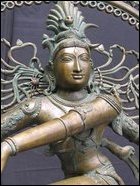
Dancing Siva is known as Kooththan in Tamil devotional literature. [Photo courtesy: lotussculpture.com]
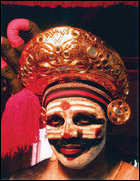
Chaakkiyar-kooththu, Kerala. The Chaakkiyar are a community of theatrical artists attached to temples of Kerala. This community and the kooththu are mentioned in Chilappathikaaram. Kerala is a repository of many forms of ancient Tamil kooththu, even though they are sanskriticised in theme now. [Photo courtesy: artkerala.com]

Nangiyar-kooththu, Kerala. The term literally means the kooththu of women. [Photo courtesy: artkerala.com]

Thoal-paavaik-kooththu (shadow puppetry), Kerala. [Photo courtesy: mykerala.com/puppetry]
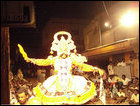
Theruk-kooththu (street play), Tamil Nadu, still performed as a folk theatre. [Photo courtesy: !!devi!! photostream, Flickr.com]
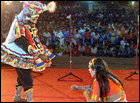
Theruk-kooththu (street play), now institutionalized as an elite theatre by Kannapa Thambiran Group. [Photo courtesy: The Hindu]
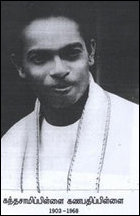
Professor K. Kanapathipillai: Hailing from Point Pedro, Jaffna, Kanapathipillai was a student of Rev. Fr. Kingsbury (Son of C.W. Thamotharam pillai) and Swami Vipulanandar at the then University college of Ceylon and at Annamalai University. He received his PhD from the University of London, and in 1948 became the professor of Tamil at the University of Ceylon, first in Colombo, and later at Peradeniya. [Photo courtesy: ThirdEye2005.blogspot]
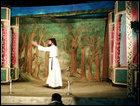
Changiliayan kooththu, performed at Chillaalai, a stronghold of Catholic Christianity in Jaffna. [Photo courtesy: sillalai.com]

St. Christopher-kooththu performed in Jaffna. [Photo courtesy: kalaikurusil.com]
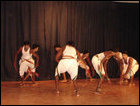
Vasanthan kooththu performed by the students of Jaffna University. [TamilNet File Photo ]
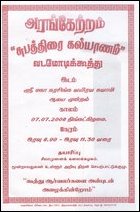
Recent efforts of reviving kooththu in the traditional villages known for it in Batticaloa through participatory research. [Photo courtesy: ThirdEye2005.blogspot]
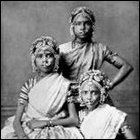
An old photograph of female temple dancers. [Photo courtesy: artword.net]
Previous columns:


















